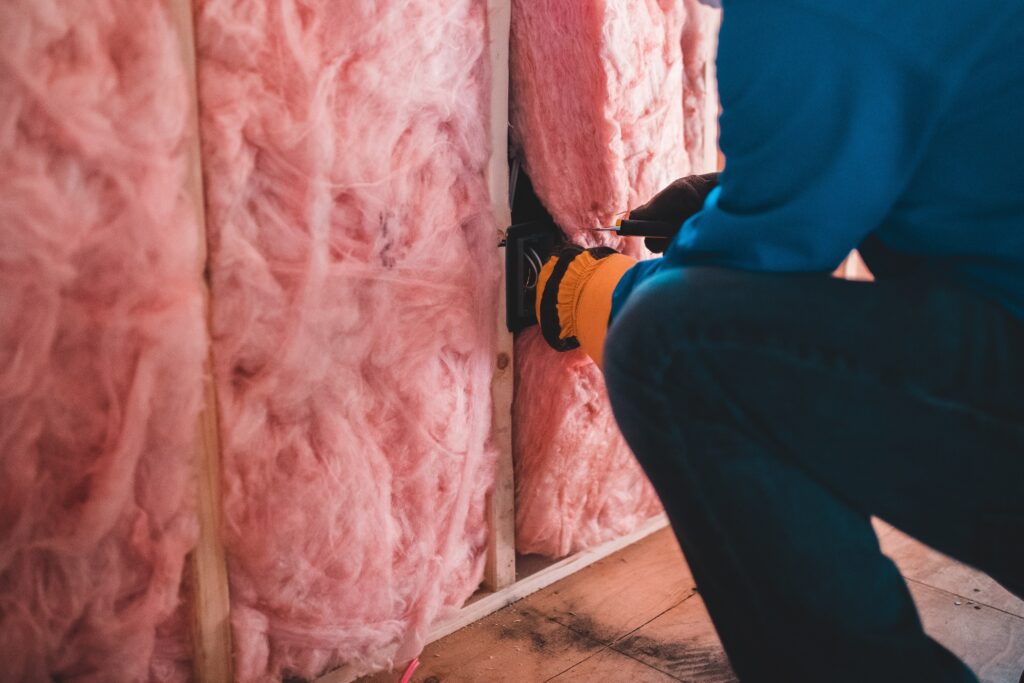If you’re working from home, you know how important it is to have a quiet and distraction-free environment. But what if you’re dealing with noisy neighbors, traffic, or other external sounds? Soundproofing your home office may seem like an expensive and daunting task, but there are actually several affordable solutions that can make a big difference even on a budget.
Before diving into the different ways to soundproof your home office, it’s important to understand how soundproofing works. Soundproofing involves reducing the transmission of sound waves from one space to another. This can be achieved by blocking, absorbing, or damping sound waves. The most effective soundproofing solutions involve a combination of these techniques.
To effectively soundproof your home office, you need to identify the sources of noise. Is it coming from outside, from other rooms in your house, or from your own equipment? Once you know where the noise is coming from, you can choose the most appropriate soundproofing solution. For example, if the noise is coming from outside, you may need to block it with soundproof curtains or weatherstripping. If the noise is coming from your own equipment, you may need to add acoustic foam panels to absorb the sound.
Key Takeaways
- Understanding how soundproofing works is important before choosing a solution.
- Identifying the sources of noise is crucial to choosing the right soundproofing solution.
- Affordable soundproofing materials and techniques can make a big difference in creating a quiet home office on a budget.
The Basics of Soundproofing a Home Office
When working from home, it’s essential to have a quiet and distraction-free workspace. If you’re struggling with external noise, soundproofing your home office can be a game-changer. In this section, we’ll cover the basics of sound waves and the difference between soundproofing and sound-absorbing.
The Basics of Sound Waves
Before we dive into soundproofing, it’s important to understand how sound waves work. Sound waves are vibrations that travel through the air and other materials. When sound waves reach an object, they can reflect, absorb, or pass through it.
When you’re trying to soundproof your home office, you want to prevent sound waves from entering or leaving the room. This can be achieved by using materials that either block or absorb sound waves.
Soundproofing Vs Sound Absorbing
Soundproofing and sound-absorbing are two terms that are often used interchangeably, but they are not the same. Soundproofing refers to the process of preventing sound waves from entering or leaving a room. This can be achieved by using materials that block sound waves, such as soundproof curtains, acoustic foam panels, or mass-loaded vinyl.
On the other hand, sound-absorbing refers to the process of reducing the amount of sound that bounces off surfaces within a room. This can be achieved by using materials that absorb sound waves, such as acoustic ceiling tiles, carpets, or sound-absorbing curtains.
When soundproofing your home office, you’ll want to consider a combination of both soundproofing and sound-absorbing materials to achieve the best results.
Identifying Noise Sources
When it comes to soundproofing your home office, the first step is to identify the sources of noise that are causing distractions and unwanted noise. Once you have identified these sources, you can take the necessary steps to block or absorb the sound.
External Noise
External noise is noise that comes from outside your home office. This can include traffic noise, construction noise, or noise from neighbors. One way to identify external noise sources is to simply listen for them. Take note of the times of day when the noise is most prevalent and try to pinpoint the source of the noise.
Once you have identified the source of the external noise, you can take steps to block or absorb the sound. For example, you can install soundproof curtains or blinds on your windows to block out traffic noise. You can also use weatherstripping or caulk to seal any gaps around your windows and doors to prevent noise from seeping in.
Internal Noise
Internal noise is noise that comes from within your home office. This can include noise from your computer, printer, or other equipment, as well as noise from other people in the house. To identify internal noise sources, try to listen for any sounds that are distracting or disruptive.
Once you have identified the source of the internal noise, you can take steps to reduce or eliminate it. For example, you can use a noise-canceling headset or earplugs to block out noise from your computer or other equipment. You can also try to schedule your work hours around times when other people in the house are less likely to be making noise.
By identifying the sources of noise in your home office, you can take the necessary steps to reduce or eliminate distractions and unwanted noise. With a little effort and some inexpensive soundproofing materials, you can create a more peaceful and productive work environment.
Cheap Soundproofing Materials if You Are on a Budget
When it comes to soundproofing your home office, it’s important to consider affordable options that won’t break the bank. Here are a few affordable soundproofing materials you can use to soundproof your home office.
Drywall and Insulation
Drywall and insulation are two of the most common soundproofing materials used in homes and offices. When used together, they can significantly reduce noise levels. You can install drywall with insulation between the studs to create a sound barrier. Rigid insulation can also be nailed to the ceiling with furring strips and resilient channels to reduce noise coming from upstairs.
Acoustic Panels
Acoustic panels are another affordable soundproofing material that can be used in your home office. They are made from sound-absorbing materials and can be placed on walls or ceilings to reduce noise levels. Acoustic panels come in different sizes and shapes, and some can even be customized to fit your specific needs.
Soundproofing Curtains
Soundproofing curtains are an affordable and easy way to reduce noise in your home office. They are made from heavy materials that can absorb sound waves and reduce echo. Soundproofing curtains can be hung over doors, windows, or walls to create a sound barrier. They also come in different colors and styles to match your home office decor.
Foam Panels
Foam panels are another affordable soundproofing material that can be used in your home office. They are made from foam and can be placed on walls or ceilings to reduce noise levels. Foam panels come in different sizes and shapes, and some can even be customized to fit your specific needs. They are easy to install and can be removed if needed.
Fiberglass Batt Insulation
Fiberglass batt insulation is another affordable soundproofing material that can be used in your home office. It is made from fiberglass and can be installed between the studs to create a sound barrier. Fiberglass batt insulation is easy to install and can significantly reduce noise levels in your home office.
When it comes to soundproofing your home office, there are many affordable options available. Whether you choose drywall and insulation, acoustic panels, soundproofing curtains, foam panels, or fiberglass batt insulation, you can significantly reduce noise levels in your home office without breaking the bank.
How to Soundproof Your Home Office on a Budget
If you work from home, you know how important it is to have a quiet and distraction-free environment. However, outside noise can be a major problem. Fortunately, there are several ways to soundproof your home office without breaking the bank. In this section, we will discuss some of the most effective and affordable methods for soundproofing your home office.
Soundproofing the Walls
One of the most effective ways to soundproof your home office is by soundproofing the walls. There are several ways to do this, including:
- Adding acoustic panels to the walls
- Hanging soundproof curtains
- Installing mass-loaded vinyl
- Adding a second layer of drywall
All of these methods can help to reduce noise transmission through the walls. Acoustic panels and soundproof curtains are relatively inexpensive and easy to install, while mass-loaded vinyl and adding a second layer of drywall may require professional installation.
Soundproofing the Floor
If you have hardwood or tile floors in your home office, sound can easily bounce around and create echoes. To reduce this effect, you can add a sound-absorbing rug or carpet. Another option is to install underlayment beneath your flooring to reduce noise transmission.
Soundproofing the Door
The door is often the weakest link in a home office’s soundproofing. To soundproof the door, you can:
- Install a solid-core door
- Add weatherstripping
- Install a door sweep
- Add a soundproof curtain or blanket
A solid-core door is more effective at blocking sound than a hollow-core door. Weatherstripping and a door sweep can help to seal gaps around the door, while a soundproof curtain or blanket can help to absorb sound.
Soundproofing the Windows
Windows are another common source of noise transmission. To soundproof your windows, you can:
- Install soundproof windows
- Add a soundproof film or sealant
- Hang soundproof curtains or blinds
Soundproof windows are the most effective option, but they can be expensive. A soundproof film or sealant can be a more affordable alternative, but it may not be as effective. Soundproof curtains or blinds can also help to reduce noise transmission through the windows.
Soundproofing the Ceiling
If you have noise coming from above, such as footsteps or voices from an upstairs apartment, you can soundproof your ceiling by:
- Adding insulation
- Installing acoustic panels
- Hanging soundproof curtains or blankets
Insulation can help to absorb sound, while acoustic panels and soundproof curtains or blankets can help to reduce noise transmission through the ceiling.
In conclusion, there are several affordable and effective ways to soundproof your home office. By soundproofing the walls, floor, door, windows, and ceiling, you can create a quiet and productive workspace without spending a lot of money.

Additional Tips for Cheap Soundproofing
If you are looking for more ways to soundproof your home office without breaking the bank, here are some additional tips to consider.
Using Blankets and Rugs
One inexpensive way to soundproof your home office is to use blankets and rugs. Hang blankets on the walls to absorb sound and prevent echoes. You can also place rugs on the floor to help reduce noise. Soft rugs work better than hard ones because they absorb more sound.
Sealing Air Vents and Holes
Air vents and holes in your walls and doors can let in a lot of noise. To prevent this, seal any gaps or openings with caulk, weatherstripping, or weatherstripping tape. You can also use soundproof weatherstrip to seal the gaps around your windows and doors. This will help keep the noise out and create a more peaceful workspace.
Using Furniture for Sound Absorption
Another way to soundproof your home office is to use furniture for sound absorption. Place bookshelves, cabinets, or other large pieces of furniture like sofas against the walls to help absorb sound. You can also use acoustic panels on the walls to reduce noise. If you have hardwood floors, consider adding a thick rug or carpet to help absorb sound.
Remember, soundproofing your home office doesn’t have to be expensive. By using blankets and rugs, sealing air vents and holes, and using furniture for sound absorption, you can create a more peaceful workspace without spending a lot of money.
Other Affordable Soundproofing Solutions
If you’re looking for more affordable ways to soundproof your home office, there are several other solutions you can try. Here are a few options to consider:
White Noise Machines
White noise machines are a popular option for creating a more peaceful work environment. These machines produce a steady, low-level sound that can help mask distracting noises from outside your office. They’re also relatively inexpensive, with many models available for under $50.
When choosing a white noise machine, look for one with adjustable volume and tone controls. This will allow you to customize the sound to your preferences and the specific noise issues in your office. Some machines also offer additional features, such as nature sounds or built-in alarms.
Soundproof Paint
Soundproof paint is a type of paint that contains sound-dampening additives. When applied to walls, ceilings, or floors, it can help reduce the amount of noise that passes through these surfaces. Soundproof paint is typically less effective than other soundproofing materials, but it can be a good option if you’re on a tight budget.
When using soundproof paint, it’s important to follow the manufacturer’s instructions carefully. You may need to apply multiple coats or use a specific type of primer to achieve the best results. Keep in mind that soundproof paint can also be more difficult to apply than regular paint, so you may want to hire a professional if you’re not comfortable with DIY projects.
Mass Loaded Vinyl
Mass loaded vinyl (MLV) is a heavy, flexible material that can be used to soundproof walls, floors, and ceilings. It’s typically made from a combination of vinyl and other materials, such as barium sulfate or calcium silicate. MLV is relatively affordable and easy to install, making it a popular choice for DIY soundproofing projects.
When using MLV, it’s important to choose a thickness and weight that’s appropriate for your specific needs. Thicker, heavier MLV will provide better soundproofing, but it can also be more difficult to work with. You may also need to use additional materials, such as acoustic caulk or insulation, to achieve the best results.
Overall, there are several affordable options available for soundproofing your home office. Whether you choose a white noise machine, soundproof paint, or mass loaded vinyl, be sure to carefully consider your specific needs and budget before making a decision. With a little research and effort, you can create a more peaceful and productive work environment without breaking the bank.
Maintaining a Soundproof Home Office
To keep your home office soundproof, it is important to perform regular checks and replace any worn-out materials. By doing so, you can maintain a peaceful and productive workspace without breaking the bank.
Regular Checks
Performing regular checks can help you identify any potential sources of noise and fix them before they become a problem. Here are some things to check:
- Windows: Make sure your windows are properly sealed to prevent noise from entering your workspace. You can use weatherstripping or caulk to seal any gaps or cracks.
- Doors: Check the weatherstripping on your doors and replace it if it is worn out. You may also consider adding a door sweep to further reduce noise.
- Walls: Inspect your walls for any cracks or gaps that may be letting in noise. You can use acoustic caulk or sealant to fill in any gaps.
- Flooring: If you have hardwood or tile flooring, consider adding a rug or carpet to absorb sound. You can also use acoustic underlayment to reduce noise transmission.
Replacing Worn Out Materials
Over time, the materials used to soundproof your home office may wear out and need to be replaced. Here are some affordable options:
- Acoustic Panels: Acoustic panels are a cost-effective way to reduce noise in your home office. You can purchase pre-made panels or make your own using materials like foam or fiberglass.
- Curtains: Heavy curtains can help absorb sound and reduce noise in your home office. Look for curtains made from sound-absorbing materials like velvet or wool.
- Weatherstripping: If the weatherstripping on your doors and windows is worn out, replacing it can help reduce noise transmission. You can purchase weatherstripping at your local hardware store.
By performing regular checks and replacing worn-out materials, you can maintain a soundproof home office without breaking the bank. This will help you stay productive and focused, even when working from home.
Frequently Asked Questions
What are some affordable ways to soundproof a home office?
There are several affordable ways to soundproof a home office. Some of the most cost-effective solutions include:
- Sealing all cracks and holes
- Adding weatherstripping to doors and windows
- Installing soundproof curtains or blankets
- Using bookshelves or other furniture to absorb sound
- Covering walls with acoustic foam panels or egg cartons
How effective are acoustic panels for soundproofing a home office?
Acoustic panels are highly effective for reducing noise in a home office. They are designed to absorb sound waves and prevent them from bouncing off walls and creating echoes. Acoustic panels come in a variety of shapes and sizes, and can be easily installed on walls or ceilings.
Can soundproofing partitions be a cost-effective solution for a home office?
Soundproofing partitions can be a great solution for a home office, especially if you need to create a separate workspace within a larger room. These partitions are designed to block sound and create a more private environment. While they can be more expensive than other soundproofing options, they are often more effective and can be a good investment in the long run.
Are there any DIY methods for soundproofing a home office?
Yes, there are several DIY methods for soundproofing a home office. Some of the most popular options include:
- Using weatherstripping to seal doors and windows
- Covering walls with acoustic foam panels or egg cartons
- Hanging soundproof curtains or blankets
- Building a DIY soundproof booth or enclosure
Is it possible to soundproof a home office without professional help?
Yes, it is possible to soundproof a home office without professional help. Many of the most effective soundproofing solutions are easy to install and can be done with basic tools and materials. However, if you are not comfortable with DIY projects or if you have a larger space to soundproof, it may be worth hiring a professional to help.
What are some common mistakes to avoid when soundproofing a home office?
Some common mistakes to avoid when soundproofing a home office include:
- Forgetting to seal all cracks and gaps
- Using the wrong materials for soundproofing
- Not covering all surfaces, including floors and ceilings
- Overlooking the importance of ventilation and air quality
- Ignoring the need for proper lighting and acoustics
My name is Frederik
I am a passionate marketeer who loves the freedom that comes with working from home whenever I choose to do so.
I love getting nerdy with every single detail about making everything related to my home just a tiny bit better.
That is what motivates me to write about home stuff on this blog.


